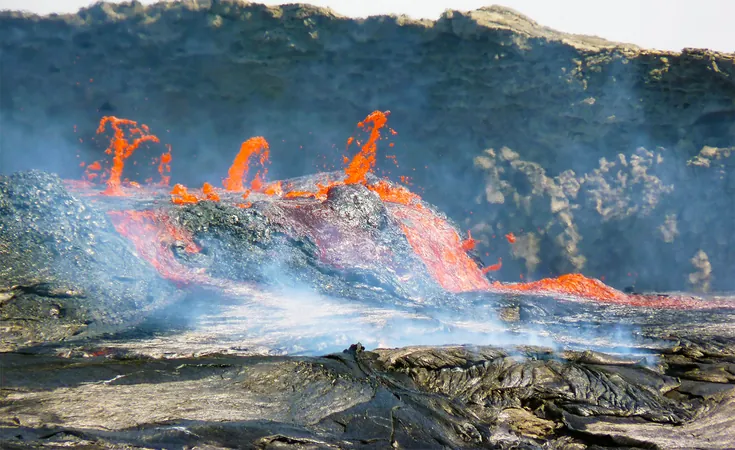
Celebrating 60 Years of Space Mission Patches: A Journey Through Artistic Excellence
2024-12-29
Author: Ling
The fascinating tradition of designing mission patches for spaceflights has now surpassed six decades, originating from the historic Vostok 6 mission in 1963 when Soviet cosmonaut Valentina Tereshkova made history as the first woman to journey into low-Earth orbit. The original patch featured a dove soaring above the letters "CCCP," symbolizing peace in an era marked by competition in the Space Race.
Initially, the Soviet space program showcased its patches only sporadically, but the practice truly took off in the United States. NASA’s inaugural mission patch emerged two years later with the Gemini 5 mission in August 1965, where astronauts Gordon Cooper and Pete Conrad embarked on an impressive eight-day journey—the longest at that time—aboard a Gemini spacecraft. Cooper, recalling the experience in his memoir *Leap of Faith*, described how he and Conrad felt strongly about their mission having its patch, differentiating it from the increasingly standardized NASA environment.
The patch they created, depicting a covered wagon with the slogan “8 days or bust,” embodied the pioneering spirit of their mission. This pivotal moment marked the beginning of a proud tradition: nearly every subsequent NASA mission has featured a unique patch, many adorned with the astronauts’ names, converging into a visual legacy that has even inspired non-human missions and other space agencies worldwide.
Spotlight on Iconic Patches:
1. **Apollo 11**: The Apollo 11 mission patch is iconic not only for its historical significance as the first human expedition to the Moon but also for its unique design. Notably, it lacks the astronauts' names—a conscious decision made by Neil Armstrong, Buzz Aldrin, and Michael Collins. Instead, the design included a bald eagle and an olive branch, symbolizing peace and the mission's focus on humanity's shared achievement.
2. **Skylab Rescue Mission**: Skylab was America’s first space station, hosting three crews between 1973 and 1974. It faced challenges, including a major operational crisis requiring the planning of a "rescue mission." Though the rescue mission wasn’t ultimately necessary, the patch designed for it stands as a testament to the innovative spirit of the time.
3. **Space Shuttle Program**: The Space Shuttle program, spanning 135 missions, showcased creativity in patch design as each crew took on the challenge. This involved a collaborative and bonding experience, where often a junior crew member would lead the design project. Notably, professional artists were occasionally brought on board to enhance the creative process.
4. **National Reconnaissance Office**: The National Reconnaissance Office, veiled in secrecy for national security reasons, employs mission patches that often convey humor while hinting at their elusive nature. These designs foster a unique sense of intrigue, inviting curiosity and appreciation while keeping the details of their missions clandestine.
5. **European Space Agency**: The ESA celebrates its diverse collaborations with innovative patches that break the conventional mold. These patches often reflect Europe's rich scientific heritage, featuring references to historical figures like Newton and Kepler while envisioning the future of space exploration.
6. **SpaceX**: In the modern era, SpaceX has emerged as a leader in creative patch design. Their missions frequently embrace the dragon motif, resulting in strikingly imaginative designs. Despite some disappointment from collectors about a decrease in patch production for certain missions, the artistry behind each patch continues to inspire.
With over sixty years of rich history, space mission patches represent more than just emblematic designs; they embody the audacity, creativity, and collaborative spirit of humanity's quest to explore the cosmos. As we look back on these artistic marvels, one can only wonder what incredible patches the future will hold as we reach for the stars.


 Brasil (PT)
Brasil (PT)
 Canada (EN)
Canada (EN)
 Chile (ES)
Chile (ES)
 Česko (CS)
Česko (CS)
 대한민국 (KO)
대한민국 (KO)
 España (ES)
España (ES)
 France (FR)
France (FR)
 Hong Kong (EN)
Hong Kong (EN)
 Italia (IT)
Italia (IT)
 日本 (JA)
日本 (JA)
 Magyarország (HU)
Magyarország (HU)
 Norge (NO)
Norge (NO)
 Polska (PL)
Polska (PL)
 Schweiz (DE)
Schweiz (DE)
 Singapore (EN)
Singapore (EN)
 Sverige (SV)
Sverige (SV)
 Suomi (FI)
Suomi (FI)
 Türkiye (TR)
Türkiye (TR)
 الإمارات العربية المتحدة (AR)
الإمارات العربية المتحدة (AR)